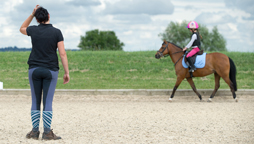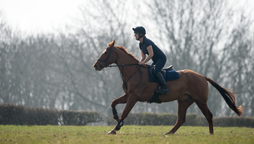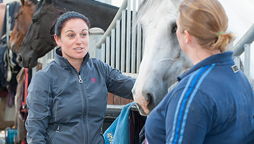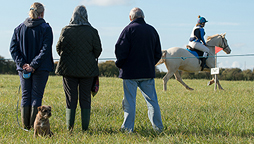Your first lesson
What to wear
To ensure your safety and comfort, it's important to be correctly attired when you arrive for your riding lesson. Here's a list of clothing and equipment you'll need...
- A riding hat. Most riding centres will be able to provide you with one, but check at the time of booking
- Boots with a small heel to prevent your foot slipping through the stirrup. Again, your chosen riding centre may be able to lend you a suitable pair
- Close-fitting clothing that allow ease of movement, such as leggings or fitted tracksuit bottoms. It's advisible to wear layers that you can take off if you get too warm
- A waterproof jacket. Some centres will hold their riding lessons outdoors, so make sure you're suitably dressed for the weather
- Long hair tied back in a braid or low ponytail that fits comfortably below your riding hat
- Items of jewellery removed for safety, as they could catch on something while you're riding
There are many places to buy proper riding clothing if you get hooked after your first lesson, and this doesn't have to be expensive. There are many specialist retailers online, as well as sports and outdoor clothing shops – and even some supermarkets!
Arriving on the yard
One the day of your lesson, try to arrive at the riding centre in plenty of time. Head to the reception/office area or ask someone on the yard where you should wait – avoid heading into any fields or approaching the horses before you know if it's safe to do so. You'll normally be met by the yard owner, manager or your coach, who will help you get ready for your lesson. In addition to fitting you for a riding hat if you need one, they'll ask you to fill out a rider registration form before you get on, which will ask for information such as contact details and any medical conditions of which your coach needs to be aware.
Meeting your mount
When meeting your horse for the first time, approach them calmly but with confidence. Ask your coach if there's anything the horse particularly likes or dislikes – some horses love having lots of fuss, while others prefer their own space. Horses and ponies have limited vision directly in front of them, so approach towards their shoulder and talk softly to them as you get closer to ensure they aren't startled. It's very important to never approach a horse from behind.
Similar to many other animals, horses rely on smell to identify people so let your horse get a good sniff of you. If they're interested in your hands, then just hold your palm out flat. Most horses love to be stroked, scratched or gently patted on their neck and shoulders - this is used as positive reinforcement when they've done something right, so your coach may remind you throughout your lessons to pat your horse.
Be aware of where your feet are – despite their size, horses are very agile and can move quickly, so keep a good distance between your feet and theirs to avoid any trodden toes.
your lesson
Your coach will take you through the process of mounting your horse and preparing to ride step-by-step, including getting into the saddle, how to hold the reins, how to place your feet in the stirrups and what body position you should have in the saddle. When you're starting out you'll most likely have a leader who'll hold on to the horse at all times, guiding them so you can concentrate on learning the commands.
What happens during your lesson will vary depending on your coach's teaching style and your previous experience. However, it's likely that they'll take your through various exercises that will help you to better understand how to steer your horse and control their speed. Remember, there are no silly questions. If you don't understand something or if you feel uncomfortable or nervous, then let you coach know and they'll try to ease your worries.
Getting off correctly is just as much of a skill as getting on, so wait for your coach to show you how when you reach the end of your lesson. Your horse will now need to be untacked and put in its stable. Most centres welcome help from their clients with this task and it's a great way to learn more about your horse.
Good luck and we hope you enjoy your first lesson!



